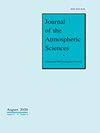Large-Scale Circulations and Dry Tropical Cyclones in Direct Numerical Simulations of Rotating Rayleigh-Bénard Convection
IF 2.8
3区 地球科学
Q2 METEOROLOGY & ATMOSPHERIC SCIENCES
引用次数: 0
Abstract
The organization of convection into relatively long-lived patterns of large spatial scales, like tropical cyclones, is a common feature of the Earth’s atmosphere. However, many key aspects of convective aggregation and its relationship with tropical cyclone formation remain elusive. In this work, we simulate highly idealized setups of dry convection, inspired by the Rayleigh-Bénard system, to probe the effects of different thermal boundary conditions on the scale of organization of rotating convection, and on the formation of tropical-cyclone-like structures. We find that in domains with sufficiently high aspect ratios, moderately turbulent (Raf ≳ 109), moderately rotating (Roc ≳ 1) convection organizes more persistently and at larger scales when thermal boundary conditions constrain heat fluxes rather than temperatures. Furthermore, for some thermal boundary conditions with asymmetric heat fluxes, convection organizes into persistent vortices with the essential properties of mature tropical cyclones: a warm core, high axisymmetry, a strong azimuthal circulation, and substantially larger size than individual buoyant plumes. We argue that flux asymmetry results in a persistent and localized input of buoyancy which allows spatially aggregated convection to sustain a warm core in a developing large-scale vortex. Crucially, the most intense and axisymmetric cyclone forms for setups where the bottom heat flux is enhanced by the nearby flow and the top boundary is insulating, as long as the convective Rossby number is higher than about 1. Our results demonstrate the great potential for dialogue between classical turbulence research and the study of convective aggregation and tropical cyclones.大尺度环流和干燥热带气旋在旋转瑞利-巴萨纳德对流中的直接数值模拟
像热带气旋一样,对流组织成相对长期的大空间尺度模式是地球大气的一个共同特征。然而,对流聚集的许多关键方面及其与热带气旋形成的关系仍然难以捉摸。在这项工作中,我们模拟了高度理想化的干对流装置,受到瑞利-巴姆纳德系统的启发,以探索不同的热边界条件对旋转对流组织规模的影响,以及对热带气旋结构形成的影响。我们发现,在长径比足够高的区域,当热边界条件约束热通量而不是温度时,适度湍流(Raf≥109),适度旋转(Roc≥1)对流组织更持久,规模更大。此外,在一些热通量不对称的热边界条件下,对流组织成具有成熟热带气旋基本特征的持续涡旋:温暖的核心、高轴对称、强方位角环流以及比单个浮力羽流大得多的尺寸。我们认为,通量不对称导致持续和局部的浮力输入,这使得空间聚集的对流在发展中的大尺度涡旋中维持一个温暖的核心。至关重要的是,只要对流罗斯比数大于1,在底部热通量被附近气流增强而顶部边界是绝缘的情况下,就会形成最强烈和轴对称的气旋。我们的研究结果显示了经典湍流研究与对流聚集和热带气旋研究之间对话的巨大潜力。
本文章由计算机程序翻译,如有差异,请以英文原文为准。
求助全文
约1分钟内获得全文
求助全文
来源期刊

Journal of the Atmospheric Sciences
地学-气象与大气科学
CiteScore
0.20
自引率
22.60%
发文量
196
审稿时长
3-6 weeks
期刊介绍:
The Journal of the Atmospheric Sciences (JAS) publishes basic research related to the physics, dynamics, and chemistry of the atmosphere of Earth and other planets, with emphasis on the quantitative and deductive aspects of the subject.
The links provide detailed information for readers, authors, reviewers, and those who wish to submit a manuscript for consideration.
 求助内容:
求助内容: 应助结果提醒方式:
应助结果提醒方式:


